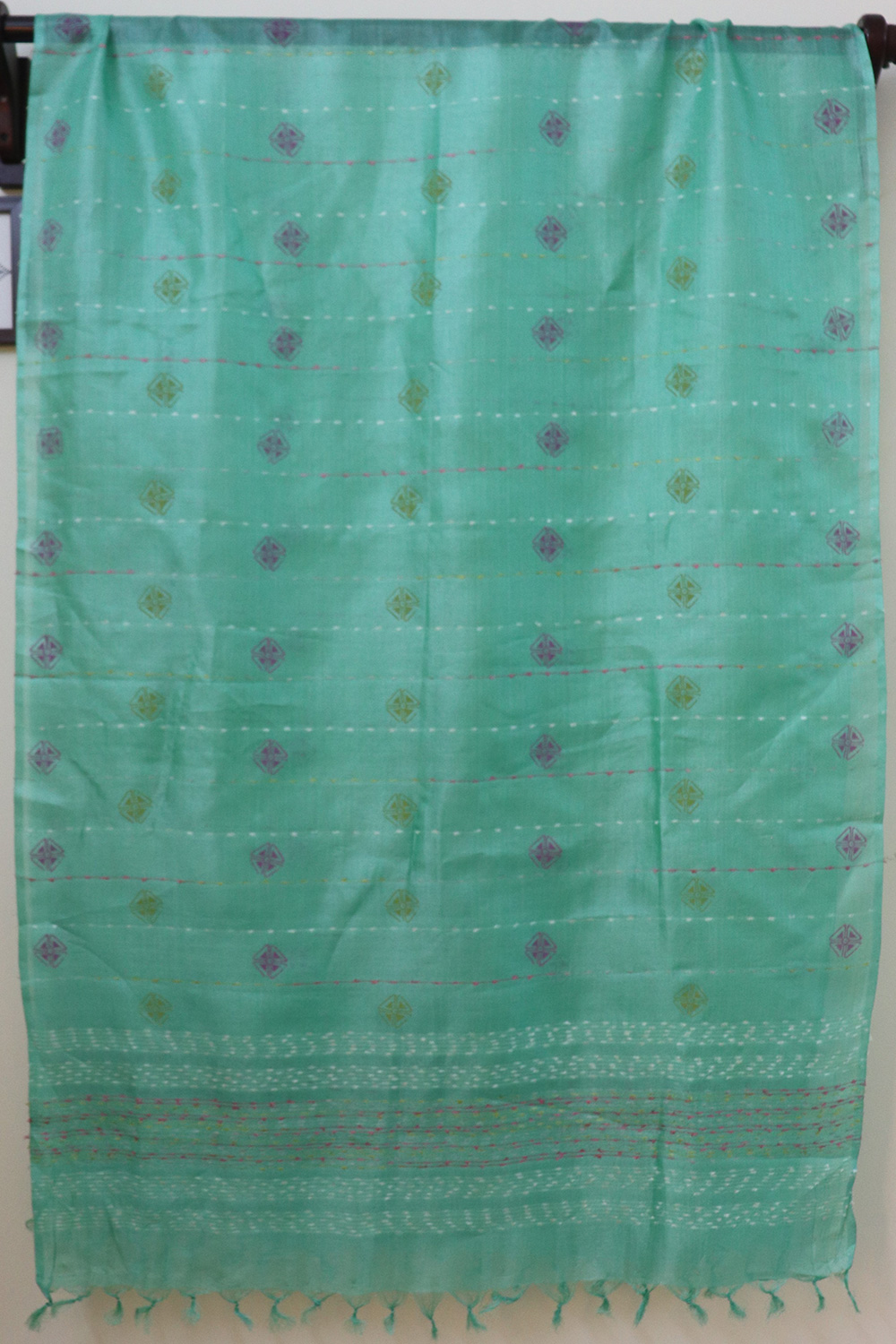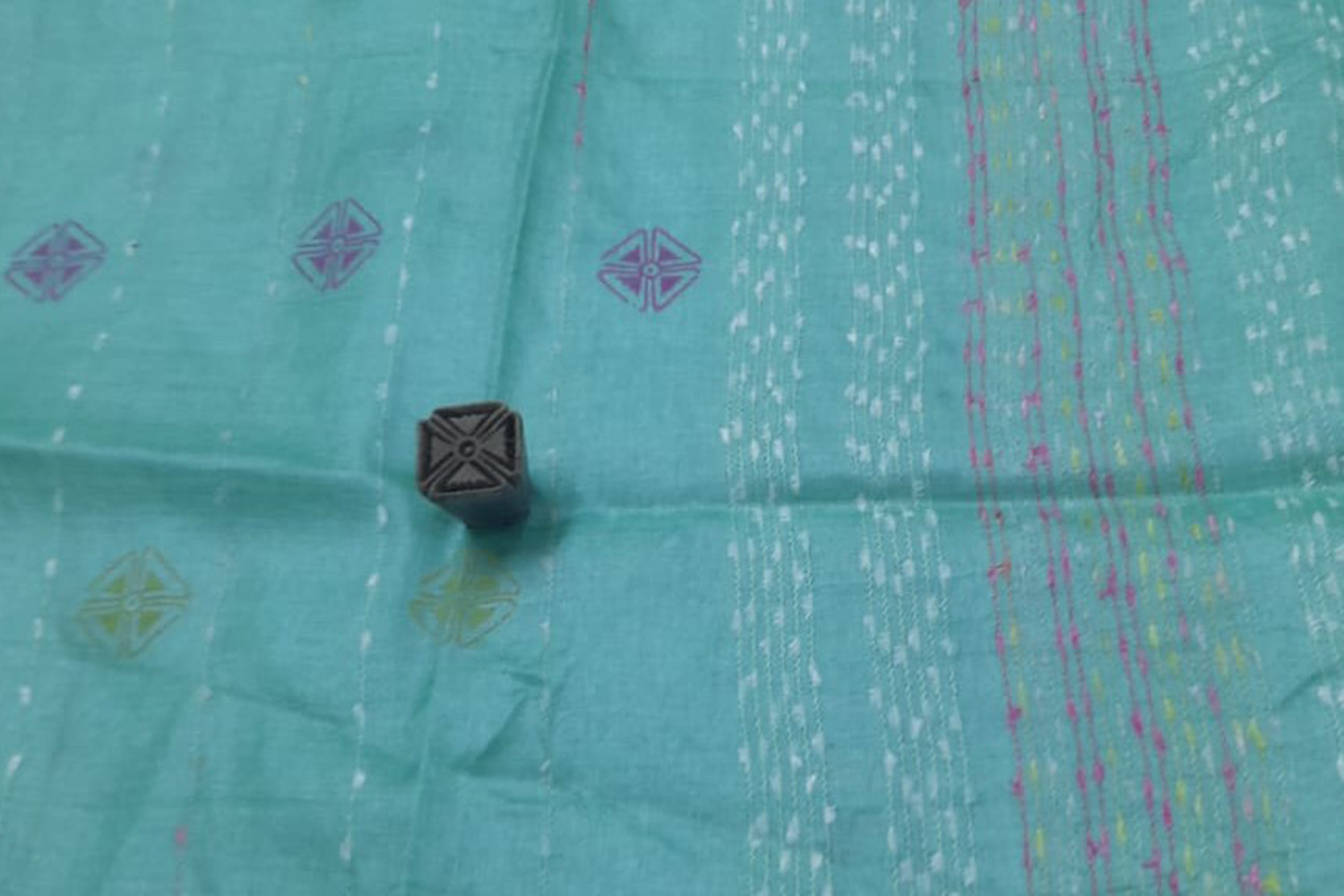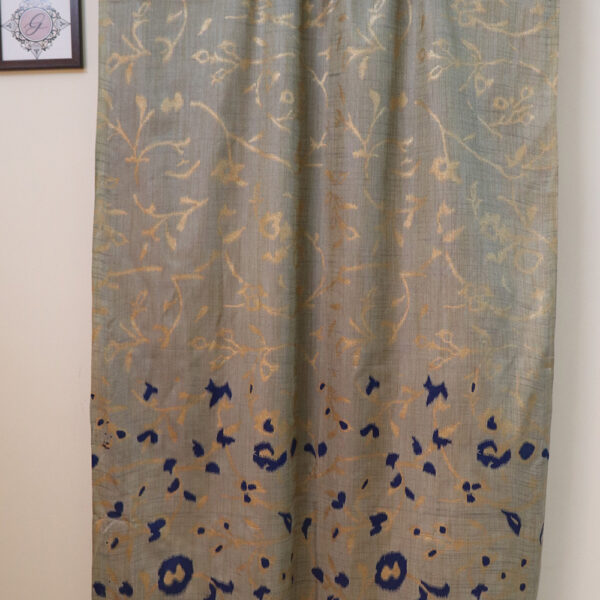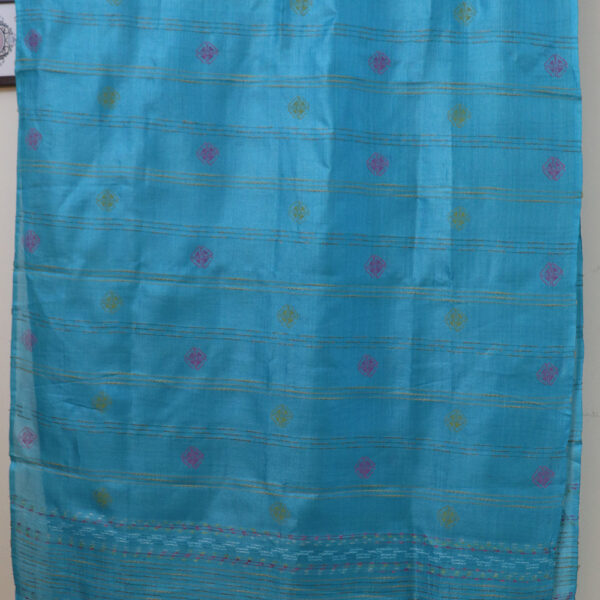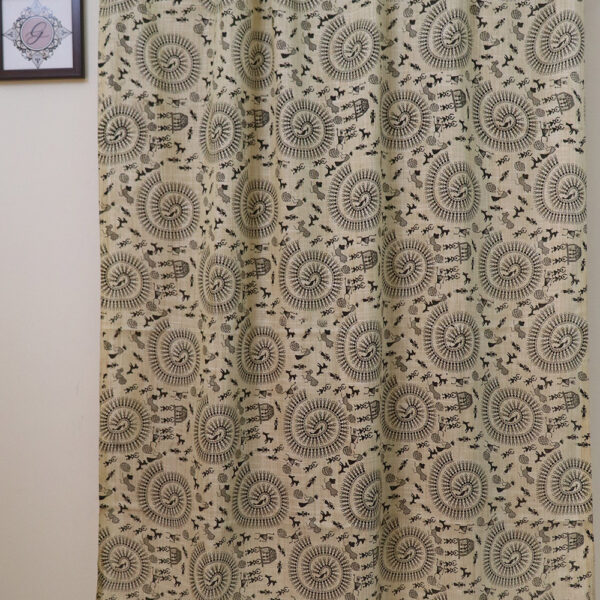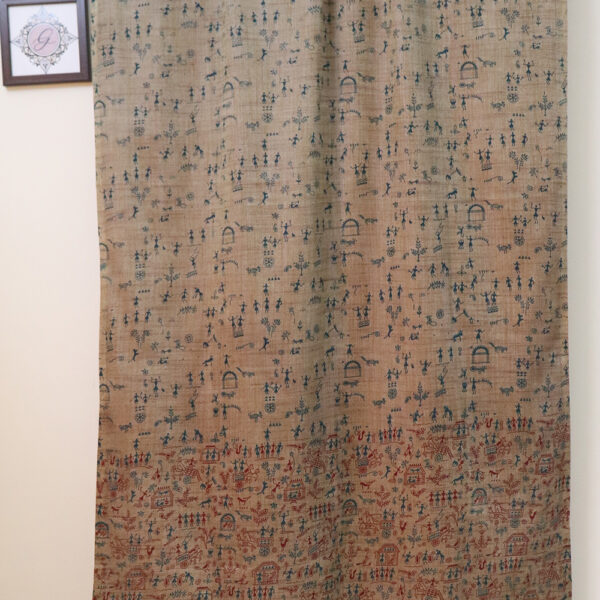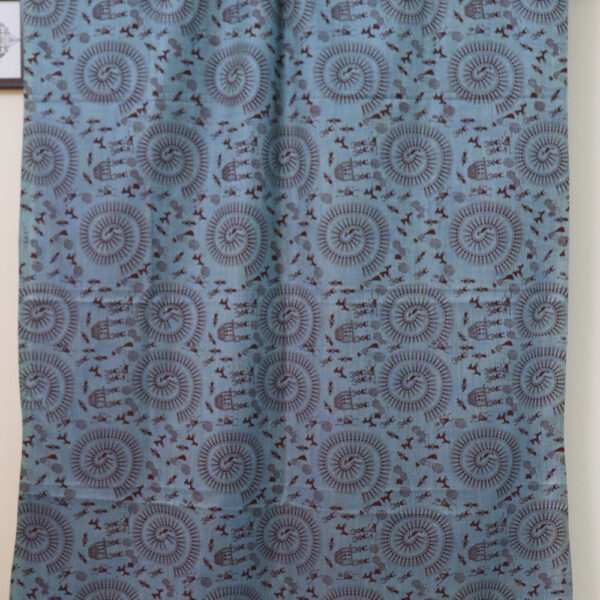Pure Tussar silk, wooden hand block printed dupatta
Length: 2.5 meters, width 0.9 meter
Washing instructions: Dry clean only, iron on the reverse
Categories
- Bags
- Stoles
- Dupattas
- Sarees
- Banarasi SareeA Banarasi sari is made in Varanasi, an ancient city which is also called Banaras. The saris are among the finest saris in India and are known for their gold and silver brocade or zari, fine silk and opulent embroidery. The saris are made of finely woven silk and are decorated with intricate design, and, because of these engravings, are relatively heavy. Their special characteristics intricate intertwining floral and foliate motifs, kalga and bel, a string of upright leaves called jhallar at the outer, edge of border is a characteristic of these saris. Other features are gold work, compact weaving, figures with small details, metallic visual effects, pallus, jal (a net like pattern), and mina work. The saris are often part of an Indian bride’s trousseau.
- Bandhani SareeBandhani sarees, also known as Bandhej, mostly come from Gujarat and Rajasthan. Bandhani is the traditional Indian tie and dye art used to produce beautiful and delicate dotted patterns on fabrics. The vibrant spectrum of colors and elegant designs make it one of the most adored fabrics in every woman’s wardrobe.
- Banswara Saree
- Begumpuri SareeBegampur is a small but well known village in Chanditala II block, Hooghly district in West Bengal. Handloom weaving is the main occupation of the residents of a village. These easy-to-maintain cotton sarees do not require frequent starching. Begumpuri sarees with deep and bright colours, are characterised by loosely woven coarse structure with a smooth feel.
- Chanderi SareeChanderi sari is a traditional sari made in Chanderi Madhya Pradesh. The Chanderi sari tradition began in the 13th century. Chanderi saris are produced from three kinds of fabric: pure silk, Chanderi cotton and silk cotton. Traditional coin, floral art, peacocks and modern geometric designs are woven into different Chanderi patterns. The saris are among the finest in India and are known for their gold and silver brocade or zari , fine silk, and opulent motifs and embroidery.
- Hand Block Printed SareeWoodblock printing on textiles is the process of printing patterns on textiles, usually of linen, cotton or silk, by means of incised wooden blocks. It is the earliest and slowest of all methods of textile printing. Block printing by hand is a slow process. It is however, capable of yielding highly artistic results, some of which are unobtainable by any other method
- Handloom CottonHandloom cotton is well-known for its breathability when compared to mill-made cotton. Cotton handloom fabric is manufactured entirely of cotton on a handloom machine. This fabric is softer, cooler, and absorbent, allowing more air to pass through. That is why it maintains you warm in the winter and cool in the summer.
- Handloom SilkHandloom silk is made of 100% pure silk yarn. Handloom silk sarees might be expensive compared to the other fabrics, but these sarees can be worn for decades together and passed on to generations and still the sarees won’t lose their luster, style or demand. A saree made of handloom silk consists of pure silk fabric which can never lose its luster and the zari used to weave these sarees is pure zari-made with gold or silver.
- Kantha SareeKantha also spelled kanta, and qanta, is a type of embroidery craft in the Bangladesh and eastern regions of India, particularly in the Indian states of West Bengal, Tripura and Odisha. One of the oldest forms of embroidery originating from India, its origins can be traced back to the pre-Vedic age. The earliest and most basic kantha stitch is a simple, straight, running stitch. Over time, more elaborate patterns developed, which became known as “nakshi kantha”. Nakshi comes from the Bengali word, naksha, which refers to artistic patterns.
- Kashmiri SareeThere are various fabrics that can be used for making sarees here in Kashmir. Most common ones include pashmina sarees, Kashmiri silk sarees, crepe saree and georgette saree. A Kashmiri saree will have its signature embroidery. Kashmiri saree is essentially an embroidery saree. Kashmiri sarees are embellished with beautiful, intricate embroidery which is peculiar to Kashmir such as Aari work and tilla embroidery. These sarees mostly have floral designs. Kashmiri Silk saree has a wide range of varieties in silk textile designs and it is a known fact that the Mulberry cocoon reared in the state of Jammu and Kashmir is the superior quality in the Asia. It yields a very fine fiber can be compares with the best in the world.
- Kerala SareeKerala sarees, better known as Kasavu sarees, are symbolic of Kerala’s tradition and culture. Kasavu is a soft, white or off-white, handloom cotton cloth with gold-threaded borders that originated in the South Indian state of Kerala. The white and gold sarees are unique due to their natural hues, texture and the gold border which adds to their elegance. It is believed to date back to the Buddhist era. Kasavu has evolved from being just traditional wear to innovative designs like including lovely block printed borders (in addition to the gold) and grand painted pallus depicting traditional mythological scenes to modern and mural art.
- Kota Doria SareeKota Doria is the name of a light woven fabric made of tiny woven squares (khat) which is still hand woven on traditional pit looms in Kaithoon near Kota in Rajasthan and in some of the surrounding villages. Kota Doria Sarees are made of pure cotton and mulberry raw silk yarn in the base fabric and have square like patterns known as khats on them. Gold and Silver Zari yarns are used in extra warp and extra weft for designing. The chequered weave of a Kota sari is very popular. The cotton yarn provides strength and suppleness whereas fine raw silk makes the fabric transparent and delicate. They are very fine weaves and weigh very little.
- Linen SareeLinen sarees are made from the fibres of the flax plant. It’s one of the most breathable fabrics. linen is a functional fabric that keeps you warm in winter and cool in summers.
- Mangalagiri SareeMangalagiri Sarees are produced by handicraft weaving in Mangalagiri, a town in Guntur district of the Indian state of Andhra Pradesh. It was registered as one of the handicraft in the geographical indication from Andhra Pradesh .It is woven from cotton and has the most characteristic features such like zari on the border and no woven designs on the body
- Mul Cotton SareeMul mul or muslin sarees are light weight pure cotton woven sarees without starch. They are very soft and breathable cotton fabric, it is great for Indian summer.
- Murshidabad Saree
- Organza SareeOrganza as the name suggests is crafted from a unique fabric known as organza. It is a lightweight, plain weave, sheer fabric that is made from silk. Organza fabric is a lightweight, plain weave material with a crisp hand. It has an outstanding drape.
- Pashmina Saree
- Sungudi Cotton SareeSungudi cotton is a geographical indicator of Madurai in the world of Indian textiles. Sungudi has been known to man ever since the 17th Century. Sungudi Cotton sarees combines artistic expression of Tamilians and Saurashtrians who migrated from Gujarat. The cloth is soft; the dyes are bright with distinct dots.
- Tussar SareeTussar silk is produced from larvae of several species of silkworms belonging to the moth, deep-gold colour, and varieties are produced in many countries, including China, India, Japan, and Sri Lanka. Since it is more textured than mulberry silk, tussar silk is used in creation of sarees The dull gold texture that it radiates works as a suitable base for embroideries as well as print motifs.
- Accessories

